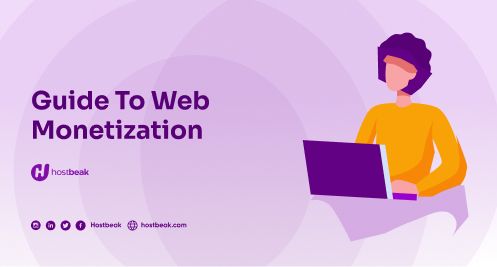Guide To Web Monetization

Before now, the ability to transfer money has been a long-standing omission from the web platform. As a result, the web suffers from a flood of advertising and corrupt business models. Web Monetization provides an open, native, efficient, and automatic way to compensate creators, pay for API calls, and support crucial web infrastructure.
What Is Website Monetization?
Website monetization is the process of making revenue from the traffic coming to the website having website monetization enabled. At this moment the most popular way to make money with the help of web monetization is with PPC - pay per click and CPI/CPM - cost per impression. Different providers act as webmasters in placing advertisements or an extension on websites to benefit from the traffic the site gets. Without monetizing your site, there will be no way of getting revenue from your website.
How can you monetize your website?
- Pay per click
- advertising
- Cost per impression advertising
- Banner advertising
- Affiliate programs
- Data monetization
- Paid subscriptions
- Donations
- Web Monetization
How does Web Monetization work?
Web Monetization is a new way to pay creators in real-time through an API that uses Interledger Protocol micropayments to monetize a website or streaming channel. Users can enable web monetization for payment streaming through polyfill or an extension. Content creators are able to implement it by adding a line of code to their website or specifying a streaming channel for web monetization.
The Interledger vision is to be able to send, receive, and monetize anything in any currency. Interledger is a payment messaging protocol for making payments of any size (and, significantly, supports “micropayments” of fractions of cents) that can be aggregated and settled over existing payment networks (which include financial institutions, Visa/Mastercard, etc.). Web Monetization providers and receivers use the Interledger protocol to exchange payments.
Content creators and websites that are making revenue from web monetization can provide rewards or special offers for users that have Web Monetization enabled, therefore creating a self-sustaining economy.
Why use Web Monetization?
- Easy to set up - all you need is a tag
- Simple to use
- Secure
- No action is required from users
- Traffic equals payment so quality content is rewarded
How to Monetize Your Site Using Coil Monetization
Coil uses new open technology, Web Monetization (a proposed W3C standard), that allows browsers to securely pay websites, and, in turn, allows for websites to react to being paid, for example by turning off ads or providing extra functionality to paying visitors.
How To Set Up Your Coil Account
- Create your Coil account: go to coil and create an account.
- Set up and link an external digital wallet: Set up a digital wallet with Uphold or Gatehub. Get your payment pointer from your wallet provider and add it to your Coil account.
- Monetize your content: Add your meta tag into the <head> section of your website. You can find your meta tag in Settings > Monetize Content
<meta name="monetization" content="$your.payment.pointer.address/xxx">What Is A Payment Pointer?
A payment pointer is a unique URL assigned to your payment account by your Web Monetization receiver. The expectation is that a Web Monetization receiver will issue one or more payment pointers to its customers and these customers will embed the pointer into the websites they want to monetize. The user's browser then fetches connection details from the pointer to open a payment stream with the Web Monetization receiver.
Payment pointers resolve to secure URLs, making it possible for Web Monetization receivers to redirect browsers to alternate addresses using standard HTTP redirects.
One benefit of payment pointers is that they provide a level of indirection that allows browsers to protect the privacy of users from their Web Monetization senders. Specifically, a browser uses a pointer to request a unique destination address and shared secret from the website's Web Monetization receiver. Only the unique destination address for the session is given to the Web Monetization sender. This prevents the WM sender from correlating a payment pointer with a website.
Receiving payments
Any entity that is able to accept payments on behalf of websites can be a Web Monetization receiver if it supports the necessary protocols. To accept a stream of payments on behalf of its users, a Web Monetization receiver MUST support the following protocols from the Interledger stack:
- Interledger Protocol (ILP) - Establishes a micropayment stream and sends payments
- Simple Payment Setup Protocol (SPSP) - Exchanges payment information between payee and payer to facilitate payment over ILP
- STREAM Protocol - Establishes micropayment streams between entities using the ILP
In conclusion, website monetization enables you to get revenue from your website and for your content. Using web monetization like coil web monetization will enable you to earn from your content without flooding your website. Also, web monetization provides you with the option of making some of your content exclusive for your paying users.